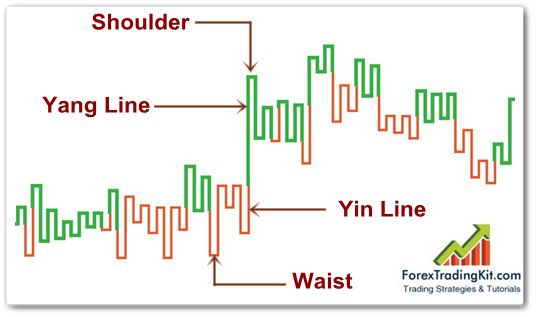Introduction to Kagi Charts
Kagi charts, consisting of thin and fat vertical lines, connected by short horizontal lines. The Kagi schedule was developed in Japan in the 1870s with the beginning of the development of the Japanese stock market. This technique was used to determine the movement of the price of rice. The word “Kagi” comes from the Japanese art of printing, it is a plate in the form of a Latin letter L, used to align a sheet of paper for printing. Western traders discovered this technique by Steve Neeson in his book “Beyond the Limits of Japanese Candles.”
The graph of Kagi does not have a time axis. The graph of Kagi looks as follows:
The thickness of the lines Kagi (Kagi) varies depending on the price action. The thick line is called the Yan line, and the thin line is called the Yin line. The points where the direction of the line changes from the top down, are called “shoulders”, and the points of change from the lower direction upwards are called “waists”.
When the line Yin (thin) moves above the previous “shoulder”, it becomes the line Yang (fat). Similarly, when the Yan line moves below the previous “waist”, it becomes the Yin line.
How to make Kagi Charts?
Note the first closing price. It is called the “base price“.
- If the closing price of the next bar is greater than the closing price of the previous (base price), draw a bold vertical line (yan) up from the price of the first bar to the price of the second bar.
- If the closing price of the next bar is less than the closing price of the previous (base price), draw a thin vertical line (yin) down from the price of the first bar to the price of the second bar.
- If the closing price of the next bar is equal to the closing price of the previous one, do not draw anything. Wait until the completion of the third bar and compare the price of its closure with the base price.
- If the closing price continues to increase (or decrease), continue moving the line tochart up (or down) to the closing price levels of subsequent bars, regardless of how small or large the movement is.
- If the closing price starts moving in the opposite direction, but the movement value is less than a certain coefficient of reversal, then this movement is ignored, and nothing is entered on the chart.
- If the Kagi line moved up and the new closing price fell by an amount greater than a certain reversal ratio, then draw a short horizontal line (called the “inflection line”) on the chart, and then – a new line down to the level of a new low closing price.
- If the Cagi linemoved down, and the new closing price rose by an amount greater than a certain coefficient of reversal, then draw a line of inflection on the chart, and then – a new line up to the level of a new high closing price.
- The coefficient of reversal, showing the amount necessary for a turn, can be expressed in absolute values (for example, 100 points) . If the magnitude of the reversal ratio is high, it will allow you to stay in a lucrative transaction longer, however, you will lose somewhat more profit when you exit the transaction. If the value of the reversal ratio is small, you will save more profit when you exit, but you will often have to exit transactions.
How to interpret Kagi Charts?
The simplest way to interpret the graphs of Kagi can be described by the phrase Stephen Nison “Buy on Yan, sell on Yin.”
When Kagi’s line of thin becomes fat, prices have risen above the previous high – it’s a bullish signal. The converse is also true: if Kagi’s line of fat became thin, then prices fell below the previous low – this is a bearish signal.
Support / resistance levels, graphical analysis, and trend analysis methods can also be used on Kagi charts. In fact, it is even easier to determine the levels of support or resistance.
Another way of interpretation, indicated by Steve Neeson, is to find a sequence of 8-10 (often going one behind the other) “shoulders” or “waists.” Usually, after this, a strong movement in the opposite direction is expected.
